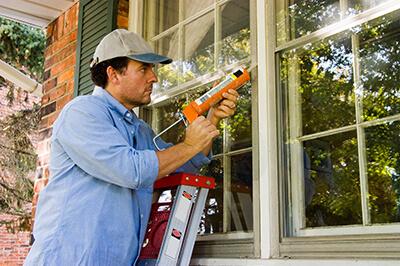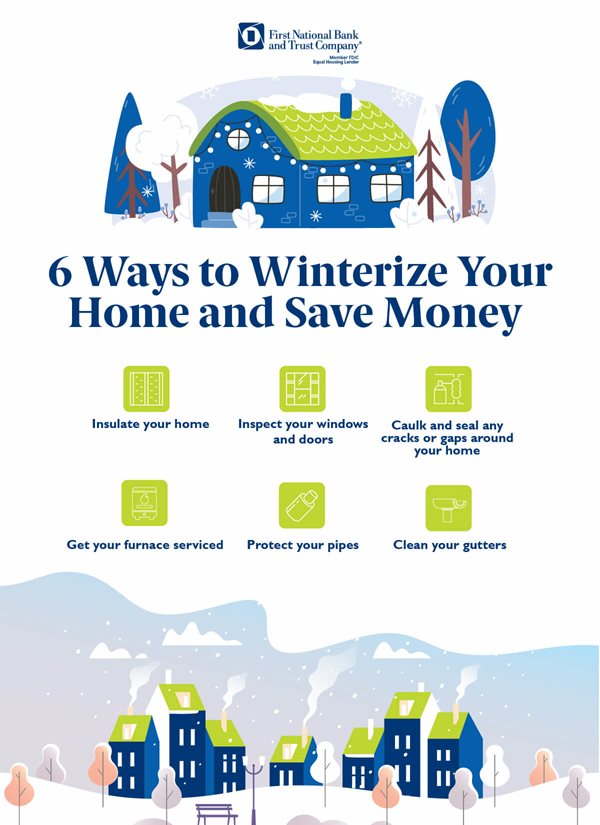Save Money by Winterizing Your Home
Ready for the long Wisconsin Winter? Here are some ways that you can winterize your home and save on your heating bills.

With energy costs on the rise, many homeowners in Southern Wisconsin and Northern Illinois are looking for sensible ways to save money. Winterizing your home is a sure way to
lower energy costs, reduce your risk of expensive repairs, improve your home’s value, and increase your comfort at home. Inflation may be chipping away at everyone’s savings, but investing in your home by winterizing it is a good way to offset the declining value of your savings by improving the market value of your house. Keep reading to learn what winterizing your home means and the steps you can take to save money on heating and get ready for the colder months.
What does it mean to winterize your home?
Southern Wisconsin and Northern Illinois experience cold and snowy winters, so it’s important for homeowners to winterize in order to avoid more expensive problems and repairs later on. Winterizing your home is the process of making needed upgrades and repairs in order to prepare your home for the cold, wind, ice, and moisture of the winter months.
The winter season can be harsh on homes and property. Frozen pipes, cracking sidewalks, falling ice, carbon monoxide leaks, and water damage are all threats posed by winter conditions. By taking practical steps such as improving your home’s insulation, upgrading windows and doors, and inspecting heating and plumbing systems, you can get the most out of your home during winter while saving money on utility bills and emergency repairs.
Insulate your home
First, check your home’s insulation. If you live in a newer home, this may not be a concern. However, many older homes have worn out, incomplete, or substandard insulation. This leads to higher utility bills and decreased comfort during the winter months.
Basements, attics, garages, and adjoining spaces are prime areas in your home where insulation may need to be replaced or complimented with something brand new. Even if the rest of your home is well-insulated, these weak spots can be sources of heat escape.
Shoring up these weak spots with professionally installed state-of-the-art insulation is a move that can pay for itself in energy savings over time. Check out the U.S. Department of Energy’s insulation guide to learn about the different types of insulation, where to insulate, and when you can do it yourself, or need to hire a professional.
The
average cost of insulation installation is $1,400-$6,300 depending on the type of insulation you choose and the size of your home. If you can’t or don’t want to pay for home insulation from savings, a small
home equity loan is an affordable way to finance a home improvement.
Inspect your windows and doors
Windows and doors can account for as much as 25% of your home’s total heat loss. This not only makes for a draftier, less comfortable interior environment; it potentially costs you hundreds of dollars every winter in heating bills.
Particularly in older homes, older model windows, frames, and doors that have sustained wear and tear will present obvious opportunities to improve your home’s energy efficiency and cold weather resilience.
Sometimes the fix is as simple as repairing the hardware that opens your windows such as latches, cranks, and locks. Depending on the problem and age of the window or door, a total replacement may be the best option.
The cost of window replacement ranges between
$200-$1,800 per window depending on your home’s layout and the type of windows you choose. Installing a new door can cost between $473-$1,635, depending on the type of door and any features, such as transoms, around it.
While these investments can be pricy, they will also improve the value of your home and your quality of life. Again, a small
home equity loan is an affordable way to finance the replacement of windows and doors.
Caulk and seal any cracks or gaps around your home
When inspecting your window and door frames, you may notice that cracks or gaps have developed over the years. Sure, you can have a new, state-of-the-art window or door installed, but if the frame is compromised it's doing you little good!
Wall trim and baseboards can also develop gaps and require maintenance. Take the time to identify any cracks and gaps; then get to work caulking and sealing them up. You don’t necessarily need a professional to do this kind of work, but you will need tools such as a caulking gun, the appropriate caulk, a putty knife, hammer, and something comfortable to kneel on.

Get your furnace serviced
Your home’s HVAC system is a complex machine that requires regular inspection, service, and maintenance to operate at peak efficiency. Annual service also helps you identify problems that can be repaired now before they turn into more expensive issues. It’s worth it to have your furnace serviced by certified professionals who will carry out an inspection and cleaning, as well as making necessary repairs or adjustments.
It’s best to schedule HVAC service before the cold kicks in, as heating and plumbing companies are often busy with heating emergencies during the winter months. Avoid having to wait in the cold for service by scheduling a visit in the summer or fall.
Should your heating system require a major upgrade or new equipment, a
home equity loan from FNBT can help cover the cost while building your equity.
Protect your pipes
Winter conditions are also a major threat to your home’s plumbing system. A frozen pipe that bursts can cause serious structural damage to your home, as well as being a major disruption to your life. It’s definitely a scenario you want to avoid. Follow these tips to protect your pipes during periods of freezing temperatures:
- Disconnect and drain outdoor attachments such as hoses, sprinklers, or swimming pool equipment to prevent your home’s internal plumbing system from exposure to outdoor conditions.
- Make sure that all your outdoor faucets and vents are properly closed off before winter weather arrives.
- Inspect your interior pipes to make sure they are properly insulated.
- If you go away during periods of cold weather, set your thermostat to at least 55 degrees. You may also want to run your taps, baths, and showers at a low velocity to keep water flowing through pipes so they aren’t simply freezing.
- Always be aware of the main water valve or shutoff in your home so you can quickly access it in an emergency.
Clean your gutters
Gutters play an essential role in protecting the integrity of your roof and home’s superstructure by diverting water to a safe location. You can clean out your gutters yourself or hire a professional to do it. Be sure to remove leaves and debris that have accumulated during the fall months before the first snowfall.
What will happen if you don’t clean your gutters? If they become blocked, the accumulated water can freeze, which may result in bursting gutters, roof damage, and potentially even more severe consequences. So, cleaning your gutters may be a hassle, but it’s better to get it over with or pay someone to do it than to end up needing to repair your roof or replace all of your gutters.
We can help winterize your home!
Now you know what you need to do to winterize your home for the long Wisconsin Winter. If you need financing to make it happen, First National Bank and Trust can help. Learn about
how to pay for home renovations and improvements. Contact us to learn about home equity loans or use our easy home loan calculator to estimate your monthly loan payment. Check our current
loan rates, or
Apply Now to get started! To apply in person, visit us at any of our
convenient locations in Beloit, Darien, Delavan, Argyle, Clinton, Janesville, Elkhorn, Monroe, Williams Bay, and Walworth, WI and Winnebago, Rockton and Roscoe, IL.